Theodor Ernst Eulenstein, 1839 - 1875
by Brian Stevenson
last updated August, 2017
Eulenstein established himself as an authority on diatoms during the mid-1860s. His most important contribution began in 1868, with the assembly and distribution of microscope slide sets of 100 different pure gatherings of diatom species. Until that time, professional and amateur diatomists prepared slides of naturally-mixed species. Such slides might be rich in the species of interest, or, as Frederick Lang complained in 1870, “in many instances the particular species to be illustrated, if it is at all a rare one, is almost smothered by the commoner and more numerous ones. This is of course a great drawback to anyone commencing the study of these organisms; as he is confounded with the multiplicity of almost similar forms, and can only with doubt and difficulty identify the one he is searching for”. Some slide-makers, such as Johann D. Möller, had begun making slides of selected and arranged diatoms, but their prices were high and were intended to be either pretty arrangements of unidentified species or arrays of one example per species, and so were not especially practical for the serious student of diatoms. Lang further noted that, “if pure gatherings of all species cannot be obtained, it is now comparatively easy to pick out those that are required from the general mass; and it is a matter of wonder to me that this has not been more generally attempted, for I am not aware of a single collection of the kind, with the exception of that which Eulenstein is now making for his subscribers”. Two of Eulenstein’s 1868 series of slides are illustrated in Figure 1, both of which contain hundreds of examples of a single species. The multitude of angles at which the frustules rest permits thorough study of each species’ structures. A second series of 100 species was planned, but was not broadly disributed before Eulenstein’s early death at the age of 35.
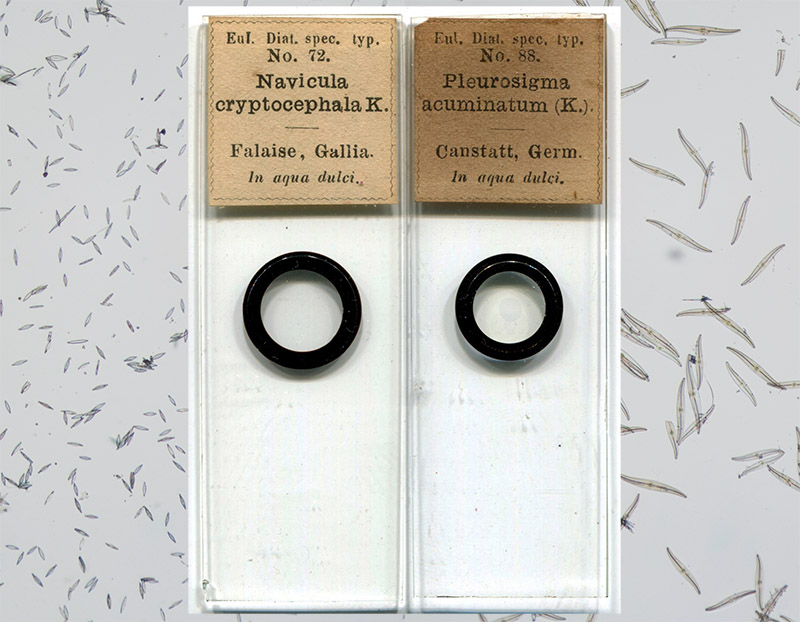
Figure 1.
Two microscope slides from Theodor Eulenstein’s 1868 “Diatomacearum species typicae”: numbers 72 and 88, Navicula cryptocephala and Pleurosigma acuminatum. To the sides are photomicrographs of the specimens, both of which are pure collections of the described species. This was a very novel idea in those days. Both photomicrographs were produced using a 10x objective lens and C-mounted digital SLR camera, and both shown at the same final magnification.
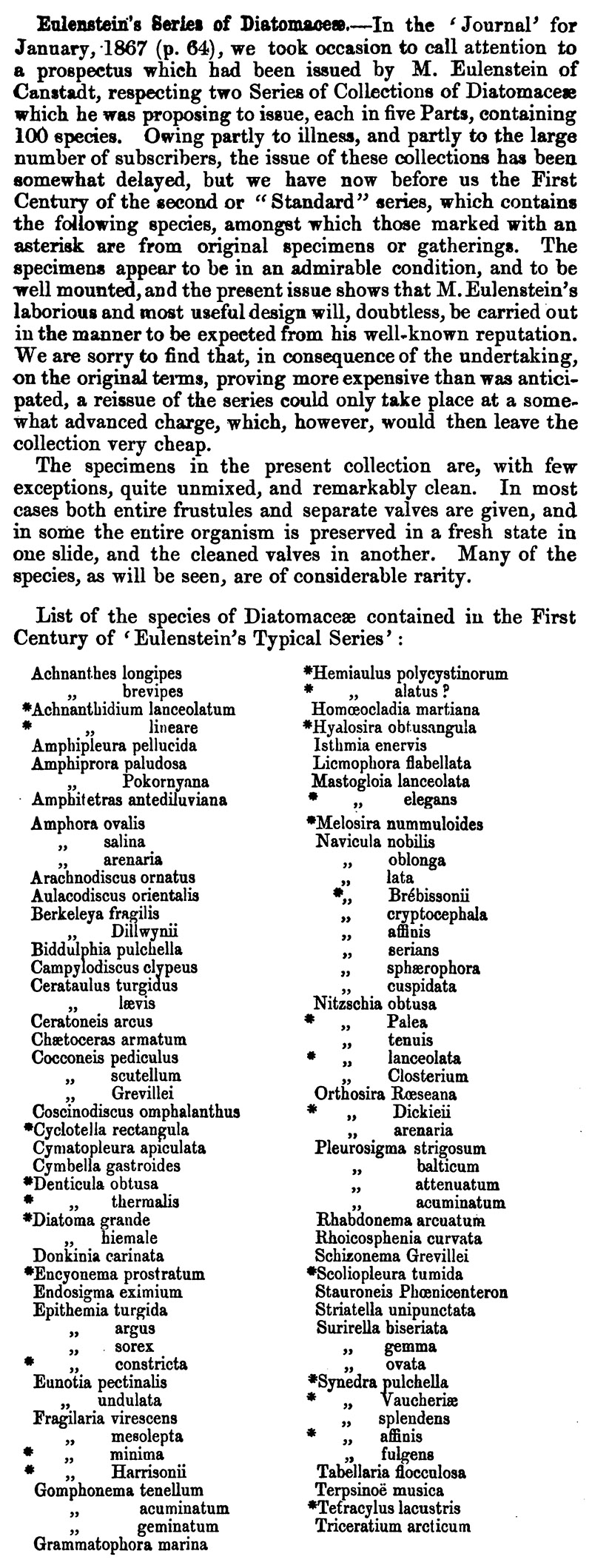
Figure 2.
Species list of Eulenstein’s first series of 100 mounted diatom species (“first century”), and a description from the ‘Transactions of the Microscopical Society of London’, 1868. Both of the slides shown in Figure 1 are included in this list. Slides of species marked with an asterisk (*) were prepared from the original collections from which each was named, thereby assuring accuracy.
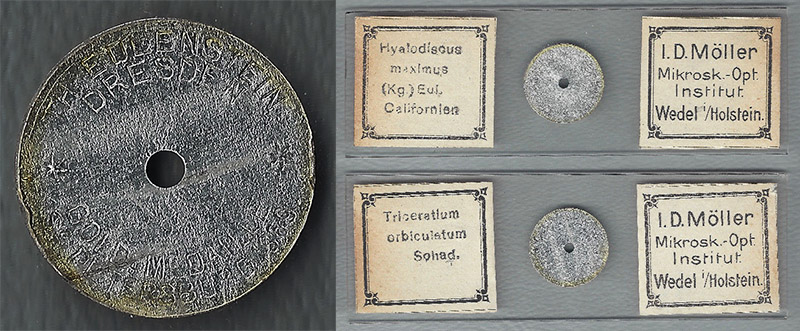
Figure 3.
Although they bear J.D. Möller’s labels, the circular metal covers are imprinted "Th. Eulenstein / Dresden / Gold Medaille / St. Petersburg 1869", identifying them as components of Eulenstein’s second series of 100 diatom species (“second century”). Presumably, Möller obtained these from Eulenstein’s heirs after the latter man’s death in 1875. Adapted for nonprofit, educational purposes from an interet auction site.
Although Eulenstein was a Germ���an who is famous for his work in Stuttgart, Dresden, and Berlin, he was born and raised in England. His father Carl (Charles) Eulenstein, was a composer and performer on the guitar and “Jew’s harp” (jaw harp), who, after many years of peripatetic life, achieved fame and settled down in Bath, Somerset. In addition to his music, Carl taught German language, and wrote several books on that topic. Theodor was the first surviving child of Carl and Henrietta, born on June 1, 1839 in Bath.
Theodor Eulenstein was acknowledged to have earned a Doctor of Philosophy (Ph.D.) degree. He moved to Stuttgart, Germany around 1860-61, and married in late 1861. All records from then through the remainder of his life describe him as being a private teacher. This suggests that he received his advanced education prior to the Stuttgart move. Directories of Dundee, Scotland, record that a “Theodore Eulenstein” was a teacher of German language and music during 1856-57 and 1858-59 (Figure 4). His advertisements describe the use of learning methods that “for twenty years has met with the greatest success in England”. That information points strongly to our Theodor as the man in Dundee. This suggests that Eulenstein received his advanced education in that city.
Theodor married Antonie Raider in Stuttgart on November 19, 1861. They had one child, daughter Antonie Victoria Marie, born in 1864.
Eulenstein’s father had a range of interests, including microscopy, and Theodor probably began his studies of diatoms and other microscopic life when he was a child. In 1864, he published a short paper on fresh-water diatoms, which concluded with a query on whether diatoms of similar shapes found in fresh and salt water were actually the same species, or did different species live in different salinities? A follow-up paper the next year offered some ideas on the topic, but did not provide conclusive answers.
Eulenstein developed a relationship with Andrew Pritchard, and two planned for the former to update Pritchard’s book on diatoms, A History of Infusoria. A revised edition was not completed before Eulenstein’s death, and so was not published.
On January 9, 1867, Theodor was elected as a Fellow of the Royal Microscopical Society. It is not clear whether he was able to attend any meetings, but society minutes indicate that he provided them with microscopical specimens.
In 1867, the Quarterly Journal of Microscopical Science announced, “Those of our readers who are more especially interested in the study of Diatoms, will be pleased to learn that M. Th. Eulenstein, of Stutgard, who is well known as one of the most active investigators of the subject, has undertaken the publication of two distinct series of specimens of Diatomaceae. One series will consist of authentic and Original specimens; and it is intended to facilitate the identification of the numerous species established by foreign authors. The uncertainty of nomenclature which has pervaded all the writings on this subject since the works of Ehrenberg and Kützing is entirely due to a want of accurate knowledge of these specimens, which M. Eulenstein has spared no pains to obtain for the present purpose.
Simultaneously with, but perfectly distinct from this series, M. Eulenstein intends also to publish another series, which will form, as it were, a Standard collection of the various types of the Diatomaceae, and will contain typical representatives of nearly all the known genera, recent and fossil.
Each series, as we learn from the prospectus, will be issued in five parts, each part containing one hundred species. The first part of the first-mentioned series will consist chiefly of specimens selected from the herbarium of Professor Kützing, and will explain many critical species established by that author in his 'Bacillaria' and 'Species Algarum’. The subsequent parts will contain original specimens illustrating the works of Ehrenberg, Heilberg, Grunnow, Rabenhorst, and others. Besides the numerous new and rare forms which will be found in this series, it will furnish systematists with a correct index to many species hitherto misunderstood, and therefore constitute an indispensable part of a very scientific collection of Diatoms.
We understand that the specimens will be carefully prepared dry or in balsam, and mounted on thin slides of the usual dimensions used in this country (3" x 1"); and to each specimen will be affixed a label with the original name, locality, &c., whilst a separate list of synonyms, with critical notes, will be published with Part V.
It is hoped that the First Part of each series will appear in the early part of, and that the entire publication may be concluded within the year.
The number of collections belonging to the first mentioned series will necessarily be extremely limited; but it is to be hoped that the London Microscopic Society will be the depository of one of them. Those of the second series would appear to be almost indispensable for all real students of the Diatomaceae, and we can only wish that M. Eulenstein may find that the pains and trouble he has bestowed upon the formation and dissemination of these collections may be properly appreciated.
We have been given to understand that besides Mr. Pritchard, Dr. L. Beale and Mr. Roper will be ready to afford any further information respecting M. Eulenstein's undertaking that may be required. [Prospectuses may be obtained, and the Collections ordered, at Messrs. R. and J. Beck's, 31, Cornhill, E.C.].”
The first series took a year longer than anticipated to prepare. The Transactions of the Microscopical Society of London wrote that this was “owing partly to illness, and partly to the large number of subscribers” (Figure 2).
Henri van Heurck later described Eulenstein’s first series (“first century”) as “a collection of preparations which leaves nothing to be desired”.
van Heurck further wrote that, “only the first 100 appeared. The second was about to appear when the author died”. However, at least some parts of the second series were released. The Harvard University Herbaria writes that they, “have not seen a complete set of the second century (no. 101-[200?]). The Farlow Herbarium has 23 slides for this century: 103, 104, 109, 112, 115, 118, 119, 129, 132, 134, 136, 137, 141, 145, 146, 148, 151, 156, 159, 164, 178, 180 and 198. I have seen in the Febiger Collection at the Academy of Natural Sciences of Philadelphia six other numbers from this century and included them in this index: 106, 108, 116, 149, 150, and 176. The second-century slides bear a cover glass rimmed with a circular metal ring bearing the impression "Th. Eulenstein / Dresden / Gold Medaille / St. Petersburg 1869" (see Figure 3, above).
Through 1868, Eulenstein lived at 9 Ulrichstrasse, Stuttgart. Around that year, he moved to Oberlössnitz, near Dresden, but retained the Stuttgart property. Business directories continued to record him as being a private teacher. Considering his upbringing, that was probably music and English language.
Theodor died on March 30, 1875, in Berlin. He was only 35 years old.
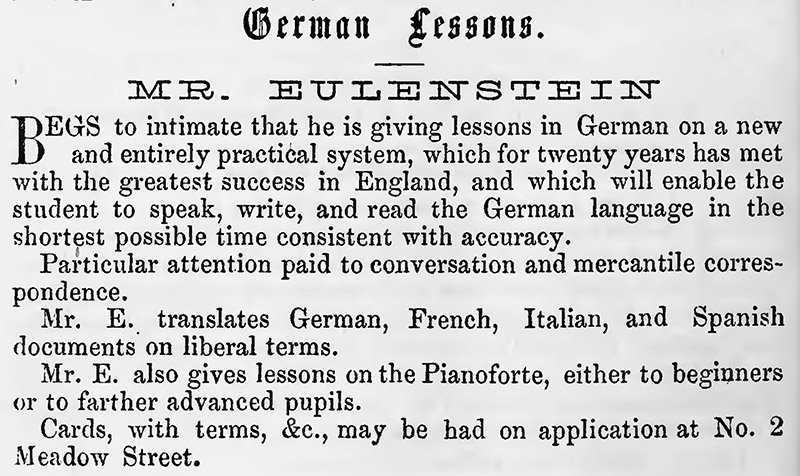
Figure 4.
An advertisement from the 1856-57 business directory of Dundee, Scotland. Other listings in the directory indicate that Eulenstein’s first name was Theodore.
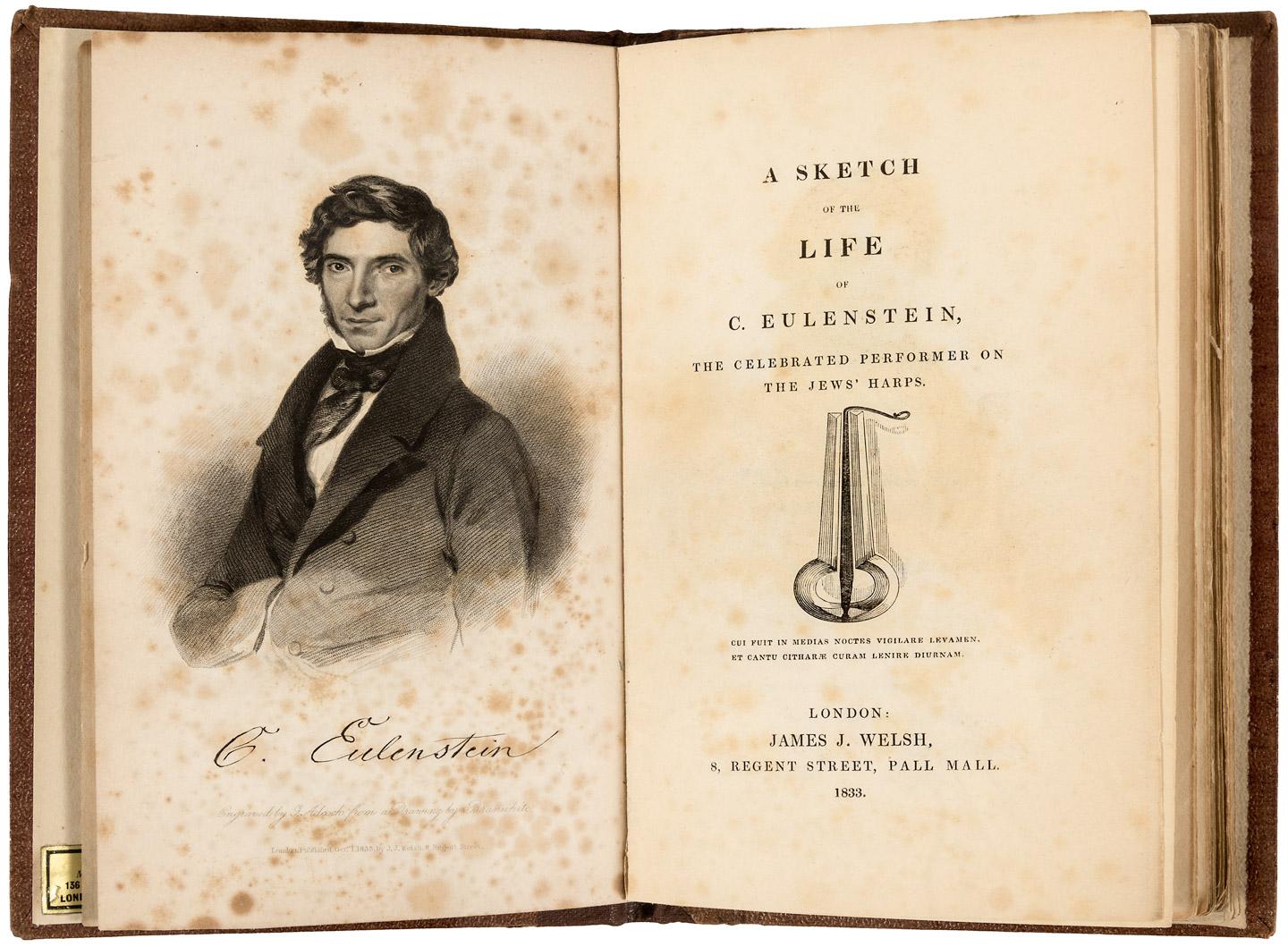
Figure 5.
Frontispiece and title page of the 1839 memoirs of Carl Eulenstein (1802-1890). Born into an impoverished family, with his father dying when Carl was young, Carl was fascinated with music and dreamed of being a musician. After a series of unsuccessful apprenticeships, he was sent to work for a hardware merchant. There, among his employer’s stock, he discovered steel “Jew’s harps” (jaw harps). At night, he taught himself to play them, and also the guitar. He was fired after his employer discovered that Eulenstein was being distracted by music. Penniless and roaming around Germany, Switzerland, and France, he had the luck to befriend musicians in Paris who engineered a concert before the King. Carl left France for England in 1827, played before that King and other royalty, and became a private musician of the Duke of Gordon, Scotland. After successful tours of Scotland, he left the Duke’s service and toured England. He settled in Bath, Somerset, and lived there for many years as a music teacher, composer, and instructor of German language. He later moved back to Germany, and died in Styria.
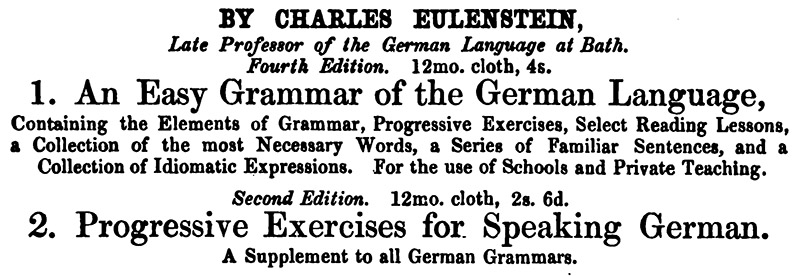
Figure 6.
An 1860 advertisement for Carl Eulenstein’s books on the instruction of the German language.
Resources
Adreß- und Geschäftshandbuch der königlichen Haupt- und Residenzstadt (Stuttgart) (1871) “Ulrichstrasse … 9 Eulenstein, Theodor, Privatgelehrter, wohnt in Dresden”, page 241
The American Naturalist (1870) Herbarium of the late Dr. Walker-Arnott, Vol. 3, page 495
The Bath Directory (1846) “Eulenstein Charles, teacher of the German language and guitar, 3, Lansdown terrace”, Post Office
Bone, Philip J. (1914) The Guitar and Mandolin: Biographies of Celebrated Players and Composers for These Instruments, Schott & Co., London
Bracegirdle, Brian (1998) Microscopical Mounts and Mounters, Quekett Microscopical Club, London, page 36
Demmler, Franz C.F. (1860) Exercises in German Grammar, D. Nutt, London, includes an advertisement for C. Eulenstein’s books on German,
The Dundee Directory (1856-1857) “Eulenstein, Theodore, teacher of German and Music, 2 Meadow Street ; h. 17 Nelson Street”, Post Office, page 91
The Dundee Directory (1858-1859) “Eulenstein, Theodore, teacher of German and Pianoforte, 17 Meadow Street”, Post Office, page 127
England census, birth, and other records, accessed through ancestry.com
Eulenstein, Charles (1833) A Sketch of the Life of C. Eulenstein: The Performer on the Jews' Harps, James J. Welsh, London
Eulenstein, Charles (1839) An Easy Introduction to the German Language, C. and H. Senior, London
Eulenstein, Theodor (1864) On Homoeoeladia in fresh water, Quarterly Journal of Microscopical Science, new series Vol. 4, pages 172-173
Eulenstein, Theodor (1865) Value of habitat as a distinctive species, Quarterly Journal of Microscopical Science, new series Vol. 5, pages 65-66
Eulenstein, Theodor (1868) Diatomaeearum species typicae, Stuttgart
Harvard University Herbarium on-line (accessed August, 2017) http://www2.huh.harvard.edu/diatom/eulenstein.htm
Hedwigia (1875) Announcement of Theodor Eulenstein’s death, Vol. 14, page 64
van Heurck, Henri F. (1896) A Treatise on the Diatomaceae, translated by Wynne E. Baxter, W. Wesley & Son, London, page 110
Journal of Botany, British and Foreign (1867) Article on Eulenstein’s proposed series of diatomaceae, Vol. 5, page 32
Lang, Frederick H. (1870) On selecting and mounting diatoms, The Monthly Microscopical Journal, Vol. 4, pages 308-311
The Monthly Microscopical Journal (1870) Pritchard’s Infusoria, Vol. 4, page 321
Quarterly Journal of Microscopical Science (1867) M. Eulenstein’s series of diatomaceae, Vol. 7, pages 64-65
Tageblatt der 41 Versammlung Deutscher Naturforscher und Ärzte (1867) “Eulenstein, Theodor, Privatgelehrter, Stuttgart”, page 46
Transactions of the Royal Microscopical Society (1867) “January 9th, 1867 … The following gentlemen were elected Fellows of the Society: … M. Theodore Eulenstein, Stutgard”, Vol. 15, page 161
Transactions of the Royal Microscopical Society (1868) Eulenstein’s series of diatomacea, Vol. 16, pages 104-105
Verhandlungen der Zoologisch-Botanischen Gesellschaft in Wien (1866) “Herr Eulenstein Theodor, Privatgelehrter, Mühlberg 13, Ulrichsst. 9, Stuttgart”, Vol. 16, page 25
Verhandlungen der Zoologisch-Botanischen Gesellschaft in Wien (1868) “Eulenstein Theodor, Privatgelehrter, Mühlberg 15, Ulrichsst. 9, Stuttgart”, Vol. 18, page 25
Verhandlungen der Zoologisch-Botanischen Gesellschaft in Wien (1869) “Eulenstein Theodor, Ob.-Lössnitz bei Dresden”, Vol. 19, page 25
Verhandlungen der Zoologisch-Botanischen Gesellschaft in Wien (1873) “Eulenstein Theodor, Ob.-Lössnitz bei Dresden”, Vol. 23, page 21





